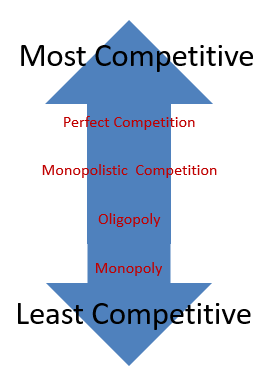Keys to Understanding Monopolistic Competition
Updated 2/24/2025 Jacob Reed
Now that you’ve learned about the most and least competitive of markets, it’s time to learn a little about one of those that falls more in the middle. Below you will review monopolistic competition. To fully understand this market structure, you need to make sure you really understand monopoly. So, if you don’t fully understand it, go back and review it first. Monopolistic competition is very similar to monopoly as you will see below.

Like All Profit Maximizing Firms:
- Produce the quantity where MR=MC
- Price at Demand
- Temporarily shut down when price falls below Average Variable Cost (AVC) at the profit maximizing quantity.
- Profit/loss is determined by the gap between the ATC and the firm’s demand curve at the profit maximizing quantity (MR=MC).
Monopolistic Competition
Number of Sellers: Many
Product Difference: Yes. Products are differentiated. In a monopolistically competitive market, each firm’s product is at least slightly different from competitors’ products. Advertising (which raises the firm’s ATC) is often used by firms in this market structure. Successful advertising shifts the firm’s demand curve right (along with the MR) and makes the firm’s demand curve more inelastic.
Ability to Affect Price: Yes. Differentiation allows the firm to have some control over price.
Graph: Since products within this market are different, each firm has a piece of the market (a mini-market). Due to the availability of substitutes offered by competitors, the firms demand curve is downward sloping. The average revenue and price will also be the demand curve. The marginal revenue curve is below the demand (as long as the firm is not a perfect price discriminator) because the firm must lower the price on all units produced when it produces higher quantities and not just the last unit produced. As a result, the marginal revenue decreases faster than average revenue. The monopolistically competitive firm produces the quantity where MR=MC but prices at the demand curve above.

Note: This graph is drawn EXACTLY like the monopoly graph you already learned.
Barriers to Entry: Low. This allows firms to enter the market when there are economic profits in the short-run which decreases the existing firm’s market size (number of buyers) and shifts the firm’s demand curve (along with the MR) to the left until the firm breaks even. When the firm breaks even, the market has reached long run equilibrium (as seen in the above graph).
When there are economic losses in the short-run, firms exit the market which increases the existing firm’s market size and shifts the firm’s demand curve (along with the MR) to the right until the firm breaks even and reaches long run equilibrium. The number of firms (offering substitutes) also impacts the elasticity of the demand curve. More substitutes means more elastic and fewer substitutes means more inelastic.


Long-run Profit: No, due to the low barriers to entry.
Efficiency: No. Monopolistically competitive firms are not allocatively efficient because they price above marginal cost and they are not productively efficient because they do not produce at the lowest average cost.
Excess Capacity: If a firm is producing at the minimum of the average total cost it has reached productive efficiency. If the firm could increase production and reduce the average total cost, it has excess capacity. Monopolistically competitive firms do not produce at the minimum of their ATC so they have excess capacity.
Compared to perfectly competitive markets: Unlike perfectly competitive firms, monopolistically competitive markets produce less, price higher, and have product differentiation (perhaps through advertising). Like perfectly competitive firms, monopolistically competitive markets have low barriers to entry, firms earn a normal profit in the long-run (zero economic profit).
Multiple Choice Connections:
2012 Released AP Microeconomics Exam Questions: 54, 57
Up Next:
Review Game: Product Market Structures Review, Shading Practice, and Prices, Points, and Quantities
Graph Drawing Practice: Monopoly and Monopolistic Competition
Content Review Page: Oligopoly Game Theory
Other recommended resources: ACDC Leadership (Monopolistic Competition)
